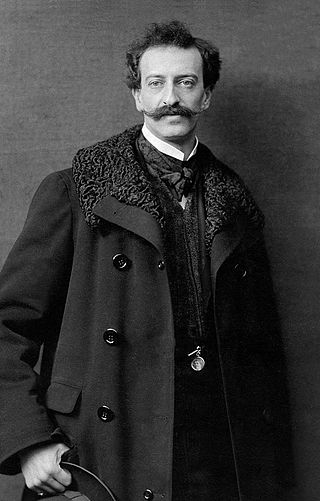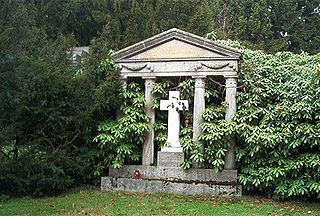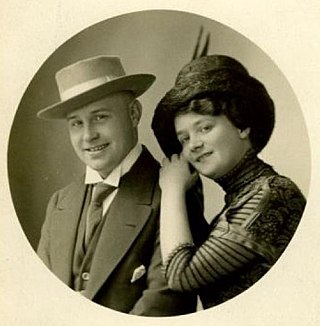
Franz Lehár was an Austro-Hungarian composer. He is mainly known for his operettas, of which the most successful and best known is The Merry Widow.

The Vienna Central Cemetery is one of the largest cemeteries in the world by number of interred, and is the most well-known cemetery among Vienna's nearly 50 cemeteries. The cemetery's name is descriptive of its significance as Vienna's biggest cemetery, not of its geographic location, as it is not in the city center of the Austrian capital, but on the southern outskirts, in the outer city district of Simmering.

Oscar Nathan Straus was a Viennese composer of operettas, film scores, and songs. He also wrote about 500 cabaret songs, chamber music, and orchestral and choral works. His original name was actually Strauss, but for professional purposes he deliberately omitted the final 's'. He wished not to be associated with the musical Strauss family of Vienna. However, he did follow the advice of Johann Strauss II in 1898 about abandoning the prospective lure of writing waltzes for the more lucrative business of writing for the theatre.

Strobl is a municipality of the Salzburg-Umgebung District (Flachgau), in the northeastern portion of the Austrian state of Salzburg, right on the border with Upper Austria. It comprises the Katastralgemeinden of Aigen, Gschwendt, Strobl, and Weißenbach.

Bad Ischl is a spa town in Austria. It lies in the southern part of Upper Austria, at the river Traun in the centre of the Salzkammergut region. The town consists of the Katastralgemeinden Ahorn, Bad Ischl, Haiden, Jainzen, Kaltenbach, Lauffen, Lindau, Pfandl, Perneck, Reiterndorf and Rettenbach. It is connected to the village of Strobl by the river Ischl, which drains from the Wolfgangsee, and to the Traunsee, into which the stream empties. It is home to the Kaiservilla, summer residence of Austro-Hungarian monarchs Emperor Franz Joseph I and Empress Elisabeth. In 2024, Bad Ischl will be one of the European Capitals of Culture – the third city in Austria after Graz (2003) and Linz (2009).

St. Marx Cemetery is a cemetery in the Landstraße district of Vienna, used from 1784 until 1874. It contains the unmarked grave of the famous composer Wolfgang Amadeus Mozart.

Also known as Friedhof Fluntern, the Fluntern Cemetery is located in the Zürichberg district of Zürich.

The Friedhof Heerstraße cemetery is located at Trakehnerallee 1, district of Charlottenburg-Wilmersdorf in Berlin, Germany, to the east of the Olympiastadion. It covers an area of 149,650 square meters.

Ohlsdorf Cemetery in the Ohlsdorf quarter of the city of Hamburg, Germany, is the biggest rural cemetery in the world and the fourth-largest cemetery in the world. Most of the people buried at the cemetery are civilians, but there is also a large number of victims of war from various nations. The cemetery notably includes the Old Hamburg Memorial Cemetery with the graves of many notable Hamburg citizens.

The Alter Südfriedhof also known as "Alter Südlicher Friedhof" is a cemetery in Munich, Germany. It was founded by Duke Albrecht V as a plague cemetery in 1563 about half a kilometer south of the Sendlinger Gate between Thalkirchner and Pestalozzistraße.

The Petersfriedhof or St. Peter's Cemetery is – together with the burial site at Nonnberg Abbey – the oldest cemetery in the Austrian city of Salzburg, located at the foot of the Festungsberg with Hohensalzburg Castle. It is one of Salzburg's most popular tourist attractions.

(German: Evangelischer Friedhof Matzleinsdorf), Matzleinsdorf Evangelical Cemetery is a historic Protestant cemetery located in the Favoriten district of Vienna, the capital city of Austria.

Hilde Spiel was an Austrian writer and journalist who received numerous awards and honours.
Spas Wenkoff was a Bulgarian-Austrian operatic tenor. He was known internationally for mastering the heldentenor roles by Wagner, such as Tristan and Tannhäuser. He appeared in his signature role Tristan first in 1975 at the Staatsoper Dresden, followed by the centenary Bayreuth Festival in 1976, and the Metropolitan Opera in 1981, among many others. He was a member of the Staatsoper Berlin from 1976 to 1984, and then appeared freelance at major opera houses. He was awarded the title Kammersänger in both Berlin and Vienna.

Feuerhalle Simmering is a crematorium with attached urn burial ground in the Simmering district of Vienna, Austria. It lies at the end of an alley, directly opposite Vienna Central Cemetery's main gate.

Rudi Gfaller was an Austrian operetta composer and singer. Born in Vienna, he began his career as an actor and singer and appeared in various provincial theatres in Germany. In 1906, he composed the first of his twelve operettas. Gfaller was married to the operetta singer Therese Wiet and often appeared with her in Leipzig where the couple were based for most of their careers. In 1943 he retired to their house in Bad Ischl where he died at the age of 89.

Therese Wiet was an Austrian operetta and concert singer whose career was based primarily in Leipzig. She was married to the operetta singer and composer Rudi Gfaller.

Lehár Villa is a building in Bad Ischl in Upper Austria, on the bank of the River Traun. It was the summer residence of the composer Franz Lehár (1870–1948). Today it is a museum dedicated to the composer.

The Hauptfriedhof in Karlsruhe is one of the oldest German communal rural cemeteries. In 1871, the first plans to build a new burial ground outside the city center began. The cemetery was laid out in 1874 by Josef Durm in the Rintheim district, east of the actual city, after the inner-city Alter Friedhof Karlsruhe in the Oststadt had become too small. The main cemetery has grown from its original size of 15.3 hectares in 1873 to over 34 hectares. The graves of more than 32,000 deceased are currently in the cemetery.


















